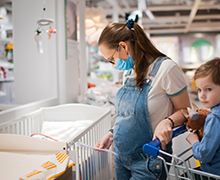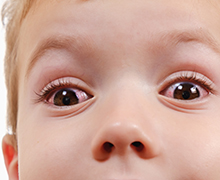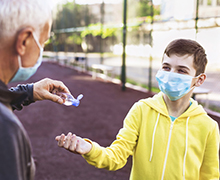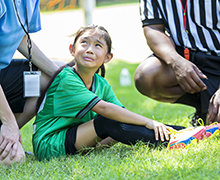Fall 2021
Anxiety Disorders Are Common and Treatable
 Anxiety is a normal emotion. However, for some kids, it’s a too-big, too-frequent feeling that affects their overall happiness — and sometimes, even their ability to function. Anxiety disorders are the most common mental health disorders among children and teens.
Anxiety is a normal emotion. However, for some kids, it’s a too-big, too-frequent feeling that affects their overall happiness — and sometimes, even their ability to function. Anxiety disorders are the most common mental health disorders among children and teens.
The symptoms vary from child to child. One common symptom is fear centered around parents or caregivers, such as being away from them, or fearing they’ll die. Kids may fear being embarrassed or making mistakes in social situations. They may worry a lot about everyday events like tests or sports contests, or huge events like global warming. Sometimes, they fixate on dirt or germs, or develop a specific phobia. These are just some of many possible symptoms.
We feel anxiety in our bodies in the form of headaches, stomachaches, racing heart, dizziness, and quick breathing. When they happen frequently, these feelings can interfere with our lives and disrupt our sleep and appetite — and may even be mistaken as symptoms of a physical illness.
Understandably, excess anxiety can lead a child to avoid situations like school, social events, and activities they once enjoyed. If untreated, this can cause them to become withdrawn and depressed.
There is no single cause of anxiety disorders. Some children seem to have an anxious nature from birth. Often, kids with anxiety disorders have parents or other family members who also have excess anxiety. In any case, it’s nobody’s fault.
Sometimes, in trying to help their child cope, parents and caregivers unknowingly model fearful behavior that can amp up their child’s symptoms rather than ease them. So, if you suspect your child has an anxiety disorder, seek expert help right away. Research shows that the treatment that helps the most is cognitive behavioral therapy (CBT), which focuses on exposures or facing one’s fears. Ideally, caregivers are active participants in this treatment; for young children, the medical expert may work just with the parents.
Your child’s doctor may be able to help you find resources or providers that specialize in this treatment. And in addition to CBT, there are many free resources available online or via apps to help get you started.
Let your child know that together, you’ll do whatever’s needed to overcome this challenge. Anxiety disorders are not lifetime disorders — this problem is changeable. With some help, anxiety won’t be calling the shots in their life anymore!
Beware of Dangerous Infant Sleep Products
 The Consumer Product Safety Commission has said it will stop companies from selling infant sleep products that do not meet sleep-safety standards. These unsafe products include infant hammocks,
The Consumer Product Safety Commission has said it will stop companies from selling infant sleep products that do not meet sleep-safety standards. These unsafe products include infant hammocks,
in-bed sleepers, and inclined sleepers. Tragically, these types of products have been linked to more than 100 infant deaths.
Unfortunately, this mandate does not go into effect until next year, and some companies that produce these unsafe products may take advantage of a loophole by removing the word ‘sleep’ from their product names — and then continue to market them.
To see whether a product has been recalled or is linked to injuries, go to www.SaferProducts.gov. Learn more about safe sleep for your baby.
Pinkeye: Causes, Symptoms, Prevention and Treatment
 Conjunctivitis, better known as pinkeye, is a common eye infection. It can be caused by the same viruses and bacteria that result in colds and other infections.
Conjunctivitis, better known as pinkeye, is a common eye infection. It can be caused by the same viruses and bacteria that result in colds and other infections.
Pinkeye can spread through coughing and sneezing, by touching an infected person, or by touching something an infected person has touched. Not surprisingly, it can sweep through daycares and schools.
Besides the red or pink color, eye discomfort is also a symptom — including itchiness and a gritty feeling under the eyelids. There may also be a goopy discharge, along with swollen eyelids and sensitivity to bright light.
Handwashing and covering coughs and sneezes help prevent the spread of pinkeye. If you think your child has it, see their healthcare provider to determine if treatment is needed. Viral pinkeye usually goes away without any treatment, while the bacterial type is treated with antibiotic eye drops or ointment. Pinkeye that’s caused by allergies or by irritants (like chlorine or smoke) is not contagious, but treatment can ease the symptoms.
Preventing Flu and COVID-19
 COVID has dominated news headlines for many months, but it’s not the only health threat out there. The seasonal flu is also heading our way. We must all take action to prevent getting sick from these contagious — and potentially dangerous — viruses.
COVID has dominated news headlines for many months, but it’s not the only health threat out there. The seasonal flu is also heading our way. We must all take action to prevent getting sick from these contagious — and potentially dangerous — viruses.
To prevent the seasonal flu, everyone 6 months and older should get the flu vaccine every year. It’s reformulated each year to protect against the flu viruses that science predicts will be most common that flu season. It takes about two weeks for the flu vaccine to protect us from the flu, so aim for you and family to get the vaccine by the end of October.
To prevent COVID-19, everyone who is eligible should get the COVID vaccine, which is now available for ages 12 and older. (A vaccine for children ages 5 to 11 is expected in early to midwinter — possibly sooner. For those under 5, it’s expected sometime in 2022.)
People are fully vaccinated two weeks after their second shot of the two-dose Pfizer or Moderna vaccines, and two weeks after the single-shot Johnson & Johnson vaccine.
It’s safe to get both vaccines at the same time. If you have questions about any vaccine, ask your doctor.
The super-contagious COVID delta variant is surging and is causing severe illness for some unvaccinated children and adults. To protect our kids and ourselves, even fully vaccinated people should mask up, avoid crowds, and practice social distancing. And to help prevent both the seasonal flu and COVID, we should always practice the basics: wash hands frequently, stay home when sick, and avoid others who are sick.
Learn about the similarities and differences between flu and COVID-19.
Growth Plate Injuries
 Children and teens have patches of growing tissue near the ends of their long bones. These areas are called growth plates, and they determine how long a child’s bones will be once they are fully grown.
Children and teens have patches of growing tissue near the ends of their long bones. These areas are called growth plates, and they determine how long a child’s bones will be once they are fully grown.
When kids break bones, they may also damage their growth plates. This can cause the bone to stop growing or to grow unevenly. Most growth plate fractures occur in the long bones of the fingers, forearms, and lower legs.
Since growth plates can’t be seen on an X-ray, a child may need an MRI or other scan to check for growth plate damage. To avoid long-term problems, it’s important to see a doctor who specializes in growth plate injuries in children and teens.
Learn more about fractures and growth plate injuries.
Picky Eaters
 It’s common for toddlers to become picky eaters, or to have less of an appetite than when they were younger. It’s also common for parents to worry that their child isn’t getting the nutrition they need — and pediatricians do a lot of reassuring on this topic!
It’s common for toddlers to become picky eaters, or to have less of an appetite than when they were younger. It’s also common for parents to worry that their child isn’t getting the nutrition they need — and pediatricians do a lot of reassuring on this topic!
Indeed, these changes in eating habits and appetite are normal. Keep offering your toddler healthy choices and keep introducing new foods — bearing in mind that they may need to be offered a new food as many as 10 to 15 times before they will eat it.
Don’t force or pressure your child to eat, and don’t keep them in their highchair if they’re clearly not interested in eating. If you’re worried or have specific concerns, talk with your child’s doctor.
Get more tips on how to handle picky eaters.
Pedestrian Safety for Kids
 As pedestrians, children are more apt to be injured than adults and older teens — mostly because of their smaller size and lack of brain development.
As pedestrians, children are more apt to be injured than adults and older teens — mostly because of their smaller size and lack of brain development.
As you go about your daily activities, talk with your child about how to be safe around traffic. Point out the sounds and sights of moving vehicles and help your child tune in to them. Be sure they understand that drivers often can’t see them — especially when their vehicle is backing up. Since young kids can’t judge the distance and speed of vehicles, don’t let children younger than 10 cross the street alone or go into it to retrieve a ball. Be a strong role model by removing earbuds, using crosswalks, and always looking left, right, and left again before crossing.
Quick Tip
Check that you have a working smoke alarm inside each bedroom, outside each sleeping area and on every level of your home, including the basement. Change batteries once a year.


